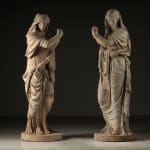A Pair of Coade Stone Statues
A Pair of Coade Stone Statues of a Sibyl and a Vestal Virgin.
Elanor Coade (1733-18211) London, dated 1792
This elegant pair of neoclassical figures were produced by the Coade manufacture at the height of its output under Eleanor Coade's direction. One is stamped COADE LAMBETH, the other, COADE, LONDON 1792.
Both figures are attributed to John Bacon the Elder, one of the leading sculptors associated with Coade's celebrated Lambeth works. First exhibited in the 1770s, the models remained in production into the early 19th century.
In classica mythology, Sibyl's were female seers believed to channel divine prophecy. Their origins span the ancient Mediterranean, with the most famous being the Camean Sibyl, whose cryptic verses were consulted by Roman leaders. Revered for their wisdom and spiritual authority, Sibyls were often portrayed in Renaissance and neoclassical arts as solemn, dignified figures, sometimes shown holding scrolls or books of prophecy. Their enduring appeal lies in the fusion of intellect, mysticism and gravitas - qualities that resonated deeply with Enlightenment-era ideals when figures like this were reimagined in sculpture and architecture.
Vestal Virgins were priestesses of Vesta, goddess of the hearth, in Ancient Rome. Chosen as young girls, they lived under strict vows of chastity and tended the eternal flame in the Temple of Vesta - believed to ensure Rome's safety and continuity. Their role conferred great honour and rare independence, including legal privileges typically denied to women. Vestals symbolised purity, devotion and civic duty, making them potent emblems of idealised femininity in neoclassical art. In sculpture, they are typically shown with calm composure and veiled drapery, echoing their sacred and secluded lives at the heart of Roman religious tradition.
Eleanor Coade was a visionary entrepreneur and one of the few women to achieve lasting success in the male-dominated world of 18th century sculpture and architectural ornament. In 1769, she perfected a secret formula for an artificial stone - now known as Coade stone - remarkable for its durability, crispness of detail and resistance to weathering. From her Lambeth manufactory, she oversaw the production of statuary, garden ornaments and architectural elements for many of Britain's leading architects and designers, including Robert Adam, John Shane and John Bacon. Today, her work survives in some of the finest English country houses and royal palaces, a testament to both her technical innovation and artistic vision.
Elanor Coade (1733-18211) London, dated 1792
This elegant pair of neoclassical figures were produced by the Coade manufacture at the height of its output under Eleanor Coade's direction. One is stamped COADE LAMBETH, the other, COADE, LONDON 1792.
Both figures are attributed to John Bacon the Elder, one of the leading sculptors associated with Coade's celebrated Lambeth works. First exhibited in the 1770s, the models remained in production into the early 19th century.
In classica mythology, Sibyl's were female seers believed to channel divine prophecy. Their origins span the ancient Mediterranean, with the most famous being the Camean Sibyl, whose cryptic verses were consulted by Roman leaders. Revered for their wisdom and spiritual authority, Sibyls were often portrayed in Renaissance and neoclassical arts as solemn, dignified figures, sometimes shown holding scrolls or books of prophecy. Their enduring appeal lies in the fusion of intellect, mysticism and gravitas - qualities that resonated deeply with Enlightenment-era ideals when figures like this were reimagined in sculpture and architecture.
Vestal Virgins were priestesses of Vesta, goddess of the hearth, in Ancient Rome. Chosen as young girls, they lived under strict vows of chastity and tended the eternal flame in the Temple of Vesta - believed to ensure Rome's safety and continuity. Their role conferred great honour and rare independence, including legal privileges typically denied to women. Vestals symbolised purity, devotion and civic duty, making them potent emblems of idealised femininity in neoclassical art. In sculpture, they are typically shown with calm composure and veiled drapery, echoing their sacred and secluded lives at the heart of Roman religious tradition.
Eleanor Coade was a visionary entrepreneur and one of the few women to achieve lasting success in the male-dominated world of 18th century sculpture and architectural ornament. In 1769, she perfected a secret formula for an artificial stone - now known as Coade stone - remarkable for its durability, crispness of detail and resistance to weathering. From her Lambeth manufactory, she oversaw the production of statuary, garden ornaments and architectural elements for many of Britain's leading architects and designers, including Robert Adam, John Shane and John Bacon. Today, her work survives in some of the finest English country houses and royal palaces, a testament to both her technical innovation and artistic vision.
Further images
-
(View a larger image of thumbnail 1
)

-
(View a larger image of thumbnail 2
)

-
(View a larger image of thumbnail 3
)

-
(View a larger image of thumbnail 4
)

-
(View a larger image of thumbnail 5
)

-
(View a larger image of thumbnail 6
)

-
(View a larger image of thumbnail 7
)

-
(View a larger image of thumbnail 8
)

-
(View a larger image of thumbnail 9
)

-
(View a larger image of thumbnail 10
)

-
(View a larger image of thumbnail 11
)

-
(View a larger image of thumbnail 12
)

-
(View a larger image of thumbnail 13
)

-
(View a larger image of thumbnail 14
)

-
(View a larger image of thumbnail 15
)

-
(View a larger image of thumbnail 16
)

-
(View a larger image of thumbnail 17
)

-
(View a larger image of thumbnail 18
)

-
(View a larger image of thumbnail 19
)

-
(View a larger image of thumbnail 20
)

-
(View a larger image of thumbnail 21
)

1
of
39




















